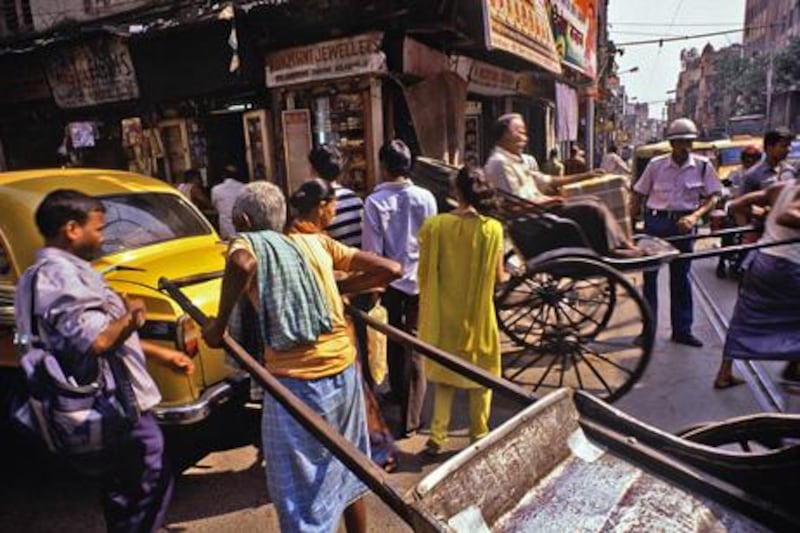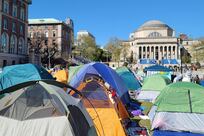Kolkata, or Calcutta, as it was known until recently, hardly features on India's tourist radar. This vast sprawling city distils - in the popular imagination at least - almost all that is ill with India. Every conceivable wound, from extreme poverty to over-population, privation, urban neglect and decay, has festered here like an abcess, resisting treatment in the heat and humidity.
Yet popular imagination can be a lopsided and stubborn thing, and Kolkata's residents will have none it. This is probably India's proudest city and its residents can readily list its disparate luminaries and achievements, from Nobel Prize winner Rabindranath Tagore to film director Satyajit Ray to India's first metro. I'd sensed their cheery pride and the city's great spirit some years back on a skimpy visit. Now I was back again for immersion. As any eager traveller can tell you, the best way to find a city is to walk its streets, be they paved with gold or caked in grime.
"It's true," admitted my guide, Husna-Tara Prakash, as we strolled down Council House Street towards the General Post Office, or GPO, "Kolkata can be a hard-sell. People - Westerners, really - seem almost afraid of it. Then, when they've been, it's often not what they expected…"
We'd begun our tour beyond a stretch of crumbling jute mills in the unassuming outer suburb of Barrackpore. Yet pivotal Indian moments began here. It was Britain's (through the East India Company) first Indian cantonment, the launch pad for her greatest imperial adventure in the so-called "jewel in the crown". "Little England" they once called it, and those barracks soon gave the place its enduring name. It was here, too, that the first shots in the 1857 Indian Mutiny (or, as some Indians have it, the First War of Independence) were fired by a soldier-martyr called Mangal Pandey; his bust now stands in a modest park.
We focused, though, on the Anglo-classical Flagstaff House. Built in stages through the 1800s for Bengal's Governors-General, its lovely gardens host 12 imposing statues of some of the Raj's great and good. An ermine-clad King George V gazes imperiously from his plinth, Lord Canning stares tight-lipped from his horse, while Lord Minto sports a plumed helmet. The statues were moved here from prime downtown locations in 1969, a time when the city's Marxist government frowned on superfluous reminders of its imperial past.
Several paintings hang beneath lofty ceilings in Flagstaff's hall. We paused by a portrait of Governor Holwell, one of the reputed 23 survivors of the Black Hole of Calcutta - a small guardroom in Old Fort William in which the nawab of Bengal's army held prisoners overnight after reclaiming the city from the forces of the East India Company in 1756. The prisoners were so tightly packed in that most had suffocated or been trampled to death by the next morning. If you've heard only one thing about the city, chances are it will be this, even though historians still question the number fatalities and intended malice. The Black Hole became, of course, a potent symbol of self-righteous imperialism hard done by those nasty unappreciative natives.
Back in the city centre, we stood outside the GPO and Husna-Tara pointed down at a discrete brass rail embedded in its steps. That, she explained, marked the south-eastern wall of the fort where the Black Hole stood.
The GPO itself boasts a huge classical dome. Under its cavernous interior stands a statue paying tribute to a "dak runner", a kind of long-distance postman clutching a spear and lantern with a mail sack over his shoulder. Cogs like these sustained the Empire.
Looking up and down BBD Bagh (formerly Dalhousie Square) and its surrounding streets, the scale of Britain's imperial enterprise becomes clear. For good reason was Calcutta once considered the second imperial city after London. A still-handsome knot of muscular edifices - Writers' Building, Government House, the former Royal Exchange and, farther away, Fort William, the huge Indian Museum and the extraordinary Victoria Memorial - stand amidst countless other lesser mansions and office buildings. The resulting streetscape of "White Town", as it used to be known, still wouldn't look out of place in Edinburgh or London.
Yet, not quite. It may be Kolkata's business and bureaucratic heart but people still bathe in BBD Bagh's large ancient Lal Dighi tank as though it were some village pond. Man-pulled rickshaws with honking horns still weave slowly through nearby streets. Beyond, where White Town gradually gives way to the vim and chaos of "Black Town", trees sometimes protrude jauntily from the upper floors of prodigiously-decaying buildings whose colour has long since faded into mottled mildew-grey. Perhaps only in Kolkata could you call this "character" and mean it.
We adjourned for lunch by the Star Theatre at Bhojohori Manna, a small chain of modest restaurants serving typical Bengali cuisine. Delicious and cheap, I relished bhetki paturi (fish in mustard seed sauce wrapped in a banana leaf), shukto (squash, string hoppers and aubergine with coconut sauce), and a spectacular item called, with fat marinated prawns cooked and served in a topped coconut. "Bengalis," Husna-Tara reminded me, "are famed for their sweets." So a bowl of mishti doi, or sweetened yogurt, was chased for research purposes with an utterly delicious natun gurer ice-cream flavoured with jaggery, a traditional unrefined cane sugar. And another.
This was proving a fine way to delve into Kolkata. We'd walk through dense cacophonous quarters swirling with humanity and then duck into small tranquil side streets. Here stood old courtyard houses with classical pillars and colonnades fronting private Hindu shrines - properties of once-prosperous Bengali clerks and administrators who absorbed European ways while working with foreign, mostly English, traders.
At Kumartali, the potters' enclave, I saw clay pots and jars still made in timeless fashion in rudimentary workshops. Its potters were preparing for a major festival and sculpting huge colourful statues of multi-armed goddesses for symbolic immersion in the sluggish River Hooghly.
By the Hooghly itself, near where the celebrated Howrah Bridge spans the river in a web of massive grey girders and beams, we paused at the Ram Chandra Goenka Zenana Bathing Ghat. The little 19th-century pavilion was built specifically for noble ladies to come and bathe in the Hooghly. Tatty and ignored now - the city's civic authorities really ought to drop by and rinse their own lamentable ineptitude - its rounded interior walls still bear European tiles bearing rosette designs. Alongside it stands the popular Armenian Ghat built in 1734, where the wealthy pious pay priests to feed pigeons.
Just round the corner and hemmed in by a railway line stretches the city's flower market at Mullick Ghat. Perhaps it's the intense light or the drab, scruffy surroundings, but those mounds of coiled marigolds and hibiscus sear your eyes with brilliant orange, yellow and crimson. We rested up for chai, India's ubiquitous sweet milky tea, at a shack any health inspector would torch. Yet its proprietor proudly set to work brewing it fresh, his beverage strong, dark and not too sweet - perfect actually and better than many five-star joints - so I downed a second and lived to tell the tale.
My tour's quirkiest element was left until almost last. Mr Surajit "Bomti" Iyengar lives in an apartment overlooking Chowringhee Road in the heart of the city. We dropped by next morning for "Breakfast at Bomti's", a curious rendezvous with someone who's happy to host complete strangers for breakfast and chat. His home is in the old Whiteway & Laidlaw Department Store, one-time Selfridges of the East. This once-stately pile with Ionic columns, pediments, domes and stained glass had, spluttered Kolkata's Telegraph newspaper in 2006, been left "a brick heap with skin like a mangy dog's". Monumental decay had become a monument to decay.
Its facade has, finally, enjoyed some much-needed restoration. Bomti told me they were currently painting its domes gold but the interior remains a surreally preposterous shell. Climbing stairs to his top-floor apartment (formerly store managers' accommodation) you pass vast dim floors, empty but for stray spore-like clusters of desks and cabinets tended by listless clerks. His apartment proved surprisingly airy, its walls lined with paintings mostly by Bengali artists, though some visitors might find the encounter a touch contrived.
We headed on to nearby St John's church. At a busy junction I heard an automated Tannoy urging pedestrians (in Bengali, Hindi and English) to take care for someone awaited them at home - strangely touching amidst Kolkata's frenetic traffic.
Modelled on London's St Martin-in-the-Fields, St John's was one of the East India Company's earliest public buildings. Our tour, it seemed, was circling back to the city's roots. In its grounds stand a fin de siècle replica of the Holwell Monument and countless memorials to Raj pioneers who were, say, struck by lightning while horse-riding or who "sunk in camp" during a sudden illness. Most compelling of all is the modest whitewashed mausoleum of Job Charnock. The bold 17th-century Company administrator married a Hindu and finally rested up here amidst a cluster of fishing hamlets in August 1690. Kolkata's founding has always been attributed to him.
Following a 2003 High Court decision, Charnock is no longer the city's official founder. History has been re-clarified, textbooks have been changed. You have to wonder, though, whether gowned Kolkata judges holding court pin their own official genesis on impoverished humble fisherfolk or hard-nosed foreign traders.
FACT FILE
Amar Grover visited Kolkata as a guest of Ampersand Travel (www.ampersandtravel.com, 00 44 (0)20 7289 6100) and the Oberoi Grand Kolkata (www.oberoihotels.com).
Glenburn Private Excursions (www.glenburnteaestate.com) arranged his walking tour, which costs from Rs16,650 (Dh1,337) per person - though much cheaper for groups of two and four - with one-, two- and three-day options.





